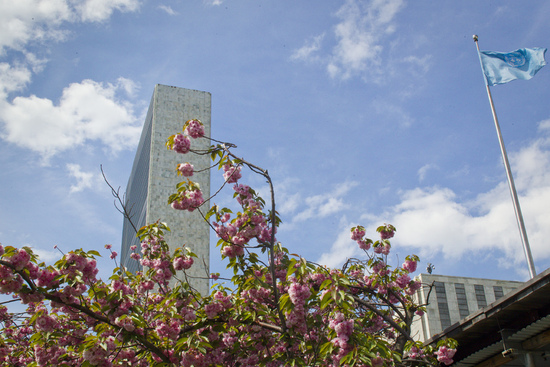
This week I was extremely pleased to view a special, global screening of One Day on Earth - the first film ever shot in every country of the world. Although it was shown in hundreds of venues in every corner of the earth, I saw it in the General Assembly Hall at the United Nations in New York. The film process began with 3,000 hours of footage, all shot on October 10, 2010.
The one hour and forty five minute film took one and a half years to edit and at times was occasionally portrayed on a split-screen -- up to 12 and 16 screens. Shot even from outer space, as the film followed the docking of the International Space Station, this documentary took a snapshot of humanity. It is a living time capsule of who we are. We have much to fix -- but we have more going for us, it seems, than not.

The film premiered this week at the United Nations and around the world. Photo: U.N.
As the wise and eloquent Helen Clark, former Prime Minister of New Zealand and Administrator of the U.N. Development Programme (UNDP) said moderating the panel afterwards, "We are all in it together." We are all inter-connected. The film captured the entire spectrum of human experience from joy and exuberance to sadness and despair, although it focused most on accentuating the positive.
One motif of the film was that humanity needs nature, but nature does not need us. This documentary offered a kaleidoscope of global experience, all reaffirming we have far more in common than not -- including a need to protect our global home.
A bride unlike any I had ever seen - with a painted face.
Love. Love was in the air -- on 10-10-10, 260,000 people met their new spouse. The film followed a Jewish wedding in California, a beach wedding in Australia, a Hindu wedding in India. There were young couples, older couples. On this day, 130 people were married globally.
Life. 363,000 babies were born on this day. Scenes of mothers holding their newborns around the world were incredibly powerful. The miracle of birth and childhood. Children on swings everywhere. Kites flying from all corners of the globe. On that day, 26 percent of the world was under 14.
Faith. Depicting acts of faith familiar and not, the film featured preaching of the Gospel in Africa, pilgrimage to Mecca, baptisms in an African river and an Asian swimming pool. The Dalai Lama extolling his followers to do more than just pray -- prayer is not enough, he said. Work for peace and social justice, he urged.
Environment. On this day, humanity produced 3.5 million tons of waste. From garbage dumps to acres of tires, vast parts of our earth seem littered and desecrated. Yet there were tree plantings and solar energy projects being built. Not enough, but a beginning.
Conflict. In Rwanda it is mentioned that the beautiful river carried noting but bodies during the genocide. On 10-10-10 there were 10 million people incarcerated and 45 countries in armed conflict.
Nature. Amazing imagery of birds, turtles, beautiful spider webs, bears fishing in Canada, and flowers from around the world. In Argentina we saw polar bears, lady bugs in Germany, and tigers in Cambodia. There were baby elephants in Botswana, horses out in the American West, deer in Switzerland, sheep in New Zealand, and cows in Iran.
Een Geschenk van Schoonheid: A Gift of Beauty.
Work. Latino day labors waiting for work at Willets Point, Queens. Fishermen in Turkey. Hammering. Soldering. Weaving. Painting. Agriculture: 30 percent of the earth on this day was used for farming.
Economics. On this day, 45 percent of humanity lived on less than $2.50 a day. Yet consumer spending on this day was $172 billion out of $4 trillion in circulation. People eating frogs, pork, chicken and breads. The film portrayed a rice commercial being made in Japan. Drinks from beer to coconut water to Coca-Cola. Yet 1.3 billion people on 10-10-10 had no access to clean drinking water. Meanwhile, the film frequently showed others in the first world easily turning on the tap.
One Day on Earth the music video - by Cut Chemist.
Music. One of the primary unifying themes of the film is music: a children's orchestra in Venezuela, music of faith, reggae, hip-hop. On this day, the U.N. calculates there were 1,300 known styles of music. My particular favorite, reminiscent of Frank Zappa playing the bicycle on the Tonight Show back in the 1960s, a man played the border fence along the U.S.- Mexican border. Phenomenal.
In short and shorter vignettes, we travelled from Sri Lanka, Guyana, Jamaica, Mongolia, Occupied Palestine, Botswana, Colombia, the U.K., Afghanistan, Indonesia, Israel, Iraq - Antarctica and the South Pole. Scenes from North Korea were spectacular.
For me, the film was about Vincent in the Netherlands who celebrated his tenth birthday on 10-10-10. As he was diagnosed with a rare disease and told he would live only until the age of 10, it was a joyous, poignant occasion. In another scene, I laughed to see the fuzzy Sesame Street characters who swarm Times Square to be photographed with tourists show up in the documentary.
The film, meant to be shown in every country on earth, is controversial in some cultures -- with unmarried couples sleeping together, lesbian couples, Rasta's smoking dope, alcohol consumption and drug addiction. It must be edited to be played in some countries.
An interview with Brandon Litman, executive producer of One Day On Earth.
There will be more films. In fact, many. The next, shot 11-11-11, will focus partially on Peace. The project will continue annually through 2015, when the U.N. Millennium Development Goals (MDGs) are hopefully reached. The film tracks all of the things that the U.N. cares about. This gives the film organization an incredible opportunity to continue recording our common humanity.
I spoke to Kyle Ruddick, the founder and director, after the screening and asked if our foundation could screen his film in our next year's documentary film festival. "Sure!"
When executive producer Brandon Litman was asked by Helen Clark what he hoped to achieve with his viewers, he replied, "Go volunteer, treat loved ones better. Peace depends on our actions. This film is about getting the world to talk - and listen."
See Stories on One Day on Earth:
New York Times: Filmmakers' First Opus Stars Everyone on Earth
National Public Radio: 10/10/10: A Day To Be Remembered (In Video)
The Telegraph: One Day on Earth Captured on Film
CBS New York: One Day on Earth
The Atlantic: 'One Day on Earth': A Video Portrait of Every Country in the World
Mashable: How Thousands of Volunteer Filmmakers Captured "One Day On Earth"
Reuters: Film "One Day on Earth" eyes new "life" in theaters
Kyle Ruddick's TEDx Talk: One Day on Earth
See Stories by Jim Luce on:
Africa | Children | China | Film | Love | Music | New York | U.N.
The James Jay Dudley Luce Foundation (www.lucefoundation.org) is the umbrella organization under which The International University Center Haiti (Uni Haiti) and Orphans International Worldwide (OIWW) are organized. If supporting young global leadership is important to you, subscribe to J. Luce Foundation updates here. Follow Jim Luce on Facebook and LinkedIn.
